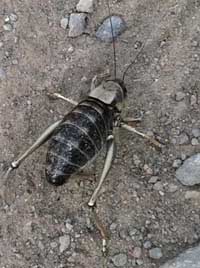They may look scary and prehistoric, but the large insects appearing on trails near Ketchum are neither unusual nor dangerous, say Forest Service officials.
"It's Mormon crickets," said Ketchum District Ranger Kurt Nelson. "[They're] a yummy bug for the right type of predator."
Mormon crickets are large, reaching over 2 inches long, big enough to startle the unsuspecting hiker who stumbles on one on a trail. Luckily, they are not dangerous to humans, only crops.
Birds are the insects' main predators, but coyotes and small mammals have also been known to use the bugs as a protein source, Nelson said.
According to Ada City-County Emergency Management in Boise, the bugs are usually brown but can also be black or green, and females are generally larger than the males.
<
The insects are not true crickets, but actually a type of katydid that got its name from the early Mormon settlers of the Salt Lake Valley. Katydids in the Salt Lake Valley invaded the fruits of the Mormon settlers' first harvest in 1847. As legend has it, a flock of seagulls swept down and devoured the crickets, saving the crops. The story lives on both in Mormon spiritual lore (known as the Miracle of the Seagulls) and in the bugs' common name.
The bugs still plague farmers today, said Lauren Hunter, extension officer for the University of Idaho Blaine County Extension.
"Alfalfa is usually what I hear complaints about," she said, adding that the insects completely defoliate the plants, leaving just a stem behind. "I visited a field last summer, and it looked like a skeleton. That field was three-quarters gone as far as its yield."
Hunter said that this year hasn't been as bad, or at least she hasn't received as many calls from farmers desperate to deter crickets. Nelson said the insects are being seen this year in places they don't usually frequent.
"They're up in fairly high elevations," he said, including Hyndman Basin in the Pioneer Mountains.
Hunter and Nelson agreed that this year's crop of crickets isn't a large outbreak, though the population has been high over the past three years or so, part of the species' population cycle. Like lemmings and other insects, Mormon crickets have a boom and bust cycle, Hunter said.
Katherine Wutz: kwutz@mtexpress.com


 A Mormon cricket rests on a trail in Adams Gulch near Ketchum last week. They may look somewhat fierce, but the bugs are not dangerous to humans. Courtesy photo by Beth Citron
A Mormon cricket rests on a trail in Adams Gulch near Ketchum last week. They may look somewhat fierce, but the bugs are not dangerous to humans. Courtesy photo by Beth Citron



































